
Not all who wander are lost!
Hundreds of human skeletons, some with frozen flesh attached to them, can still be found around Roopkund (16,500 feet), a remote glacial lake in the lap of Trishul massif in Himalayas. The presence of these skeletons was first discovered in 1942 by the Himalayan ranger H K Madhwal.
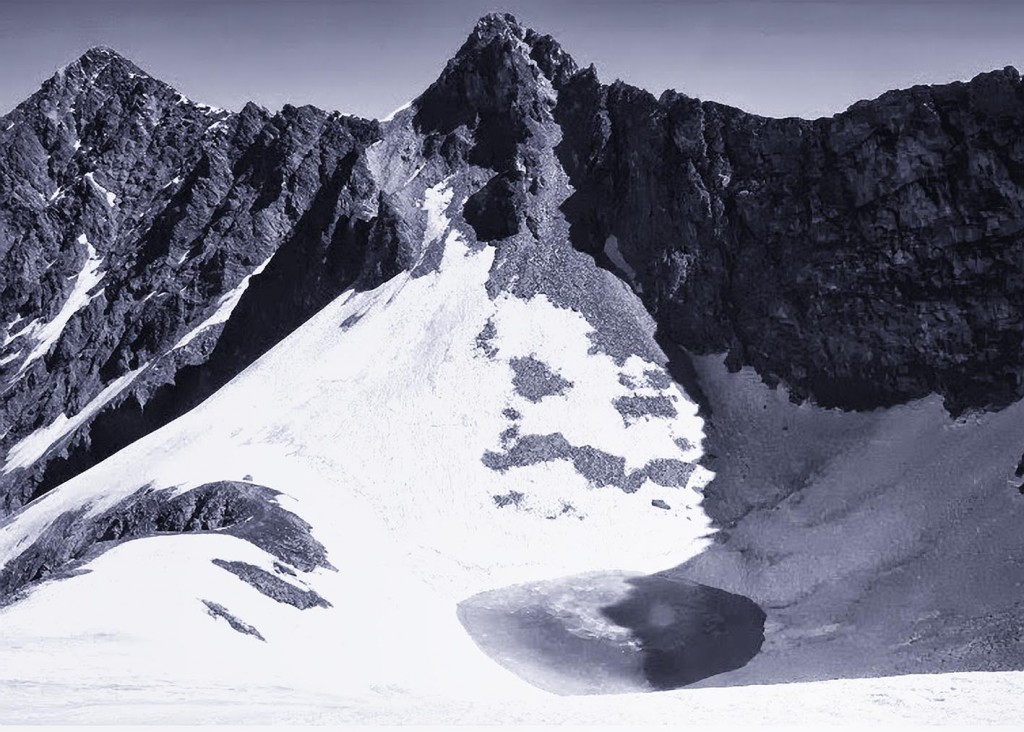
Roopkund lake, India
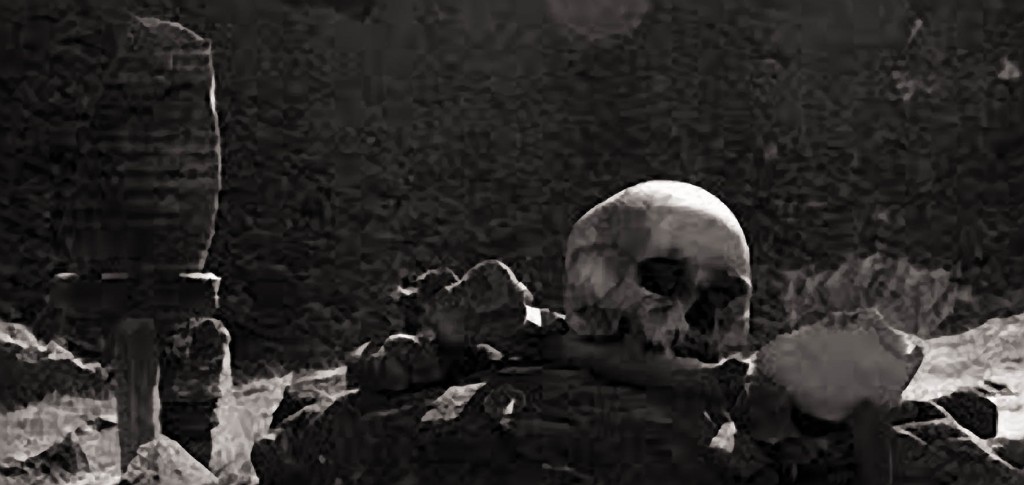
Human Skeletons at Roopkund lake, India
I was fortunate to be schooled at The Doon School, Dehradun (India), an institution that valued the importance of growth by encouraging us to trek in the Himalayas. In 1983, when I was seventeen, a group of senior students successfully trekked to Roopkund, bringing samples of human bones.
With a sense of curiosity, I asked my housemaster, Mr. Vaishnav, “Why are so many skeletons found around this remote lake?”
Mr. Vaishnav replied, “These are believed to be the remains of General Zorawar Singh’s soldiers who got lost in the Himalayas while returning from the Tibetan plateau.”
Who was General Zorawar Singh?
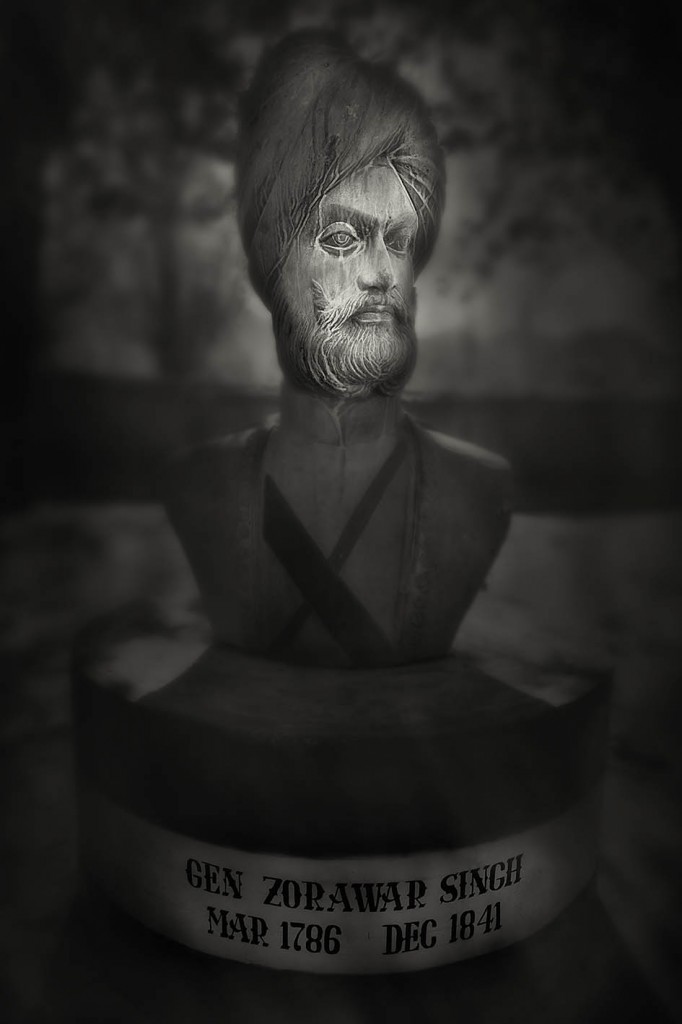
General Zorawar Singh’s statue at Fort in Leh (Ladakh)
The plains of Indian sub-continent since 9th century had been continuously invaded, looted and ruled by many dynasties. It was only with the rise of the Sikh kingdom in Punjab, during the regime of Maharajah Ranjit Singh (1780 – 1839), the “Lion of Punjab”, this trend was reversed.
Ranjit Singh’s military career can be divided into three phases.
- 1799 – 1809 : Consolidation of the Sikh forces, leading to capture of Lahore.
- 1809 – 1823 : Expansion of empire to include Multan, Peshawar and Kashmir. It is in this phase that Hari Singh Nalwa, his trusted General extended the empires reach till Khyber pass, along Afghanistan border. This was a historic achievement as only thereafter no foreign invasion to Indian sub-continent happened from Afghanistan.
- 1823 – 1839 : Consolidation and further expansion. It is in this phase that General Zorawar Singh, operating under the military leadership of Gulab Singh (the Dogra minister in Ranjit Singh’s cabinet who was asked to manage the affairs of Kashmir), led expansionary military expeditions to Ladakh (1834), Baltistan (1840) and Tibet (1841).
The British had conquered the entire India, falling East of river Sutlej and were now limited by the treaty of Amritsar, signed with Maharajah Ranjit Singh, that stopped them from making a westward advance into Punjab and beyond. It also limited Ranjit Singh from capturing territories east of river Sutlej. The only option for expansion of the Sikh kingdom was North of Kashmir into Ladakh.
Zorawar Singh was born at Khalur, now in the state of Himachal Pradesh, which was then a part of Punjab. At a very young age, he rose to become a General in Maharajah Ranjit Singh’s army.
In 1834, General Zorawar Singh led an expedition to Ladakh via Kishtwar, Dachin, Marwah, Warwan, crossing the Lanvila pass at 14,500 feet. At Suru and Leh valley, his forces constructed forts for administration of the region.
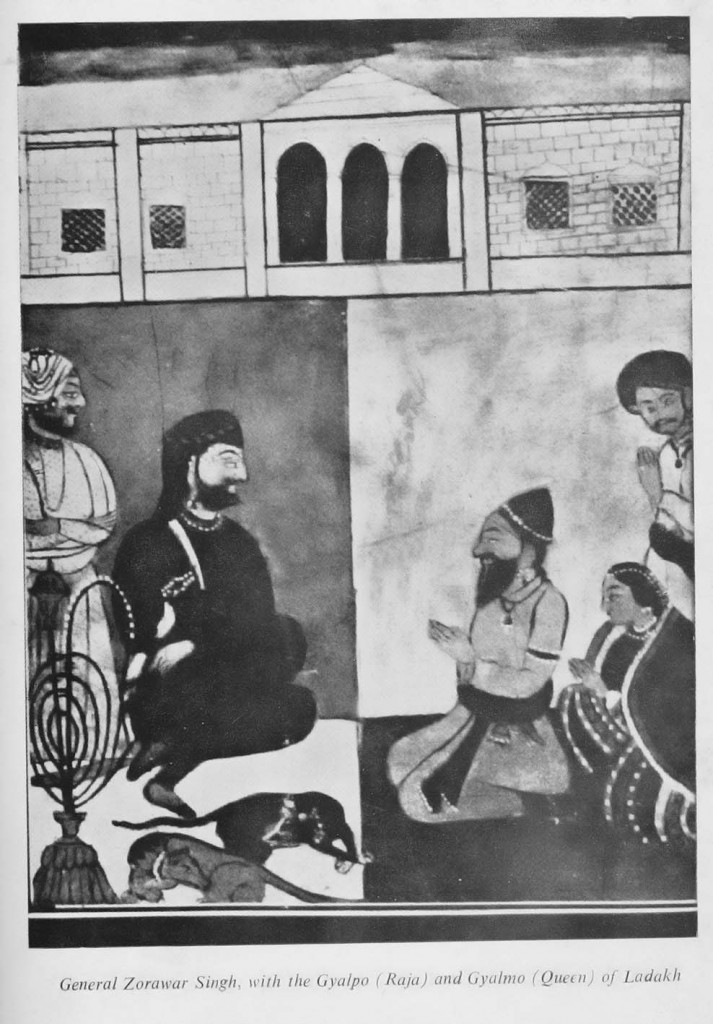
General Zorawar Singh with Gyalpo, the King of Ladakh
In October 1835, Zorawar returned to Kishtwar but on hearing reports of rebellion, he immediately turned back and this time took a shorter but more arduous route via Umasila pass at 17,300 feet into Zanskar and Leh, which he reached in ten days. An army crossing at these heights, especially in winter month of November, is one of it’s kind in the annals of world military history. Inclusion of Ladakh in Maharajah Ranjit Singh’s territory is of significant geo-political importance for the present day India. If not for the success of this expedition, with China’s conquest of Tibet in 1950, today it would be a part of China.
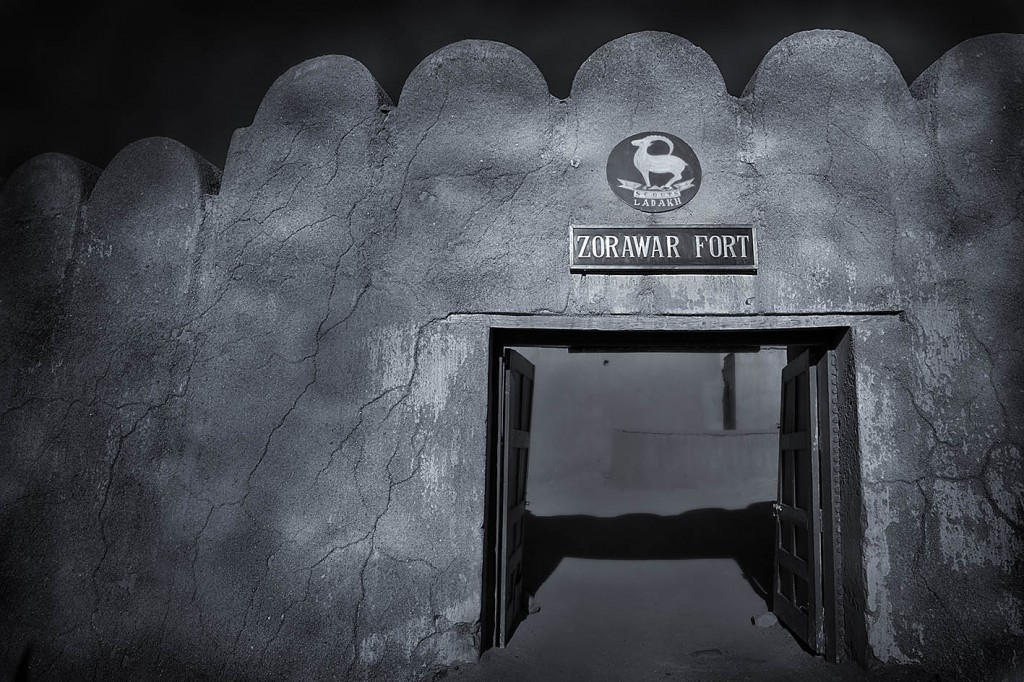
General Zorawar Singh’s fort at Leh, Ladakh
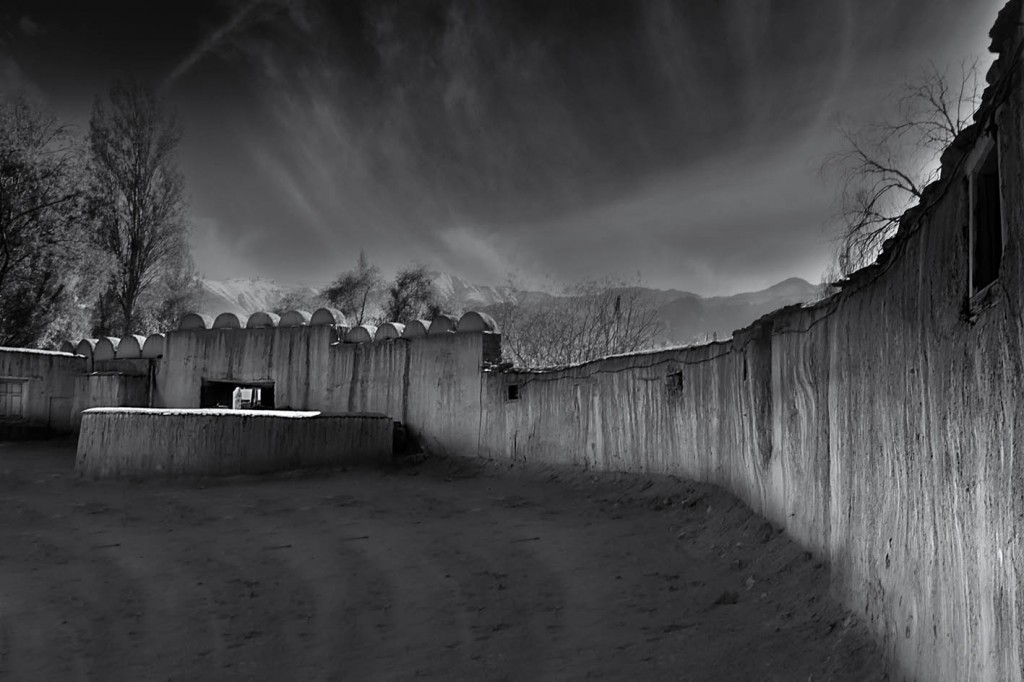
General Zorawar Singh’s fort at Leh, Ladakh
In 1840, Zorawar Singh led an expedition to Baltistan, which is believed to be one of the most rugged mountain regions of the world. It is situated in the Karakoram range to the south of K2, the world’s second highest mountain. Since 1757, Baltistan was under the rule of Ahmed Shah Durrani of Afghanistan. If not for this expedition, Baltistan would today be a part of Afghanistan. Baltistan is the region where live the Dards along with Balti people. Dards are of European origin, believed to be descendants of the soldiers of Alexander The Great (327 BC).
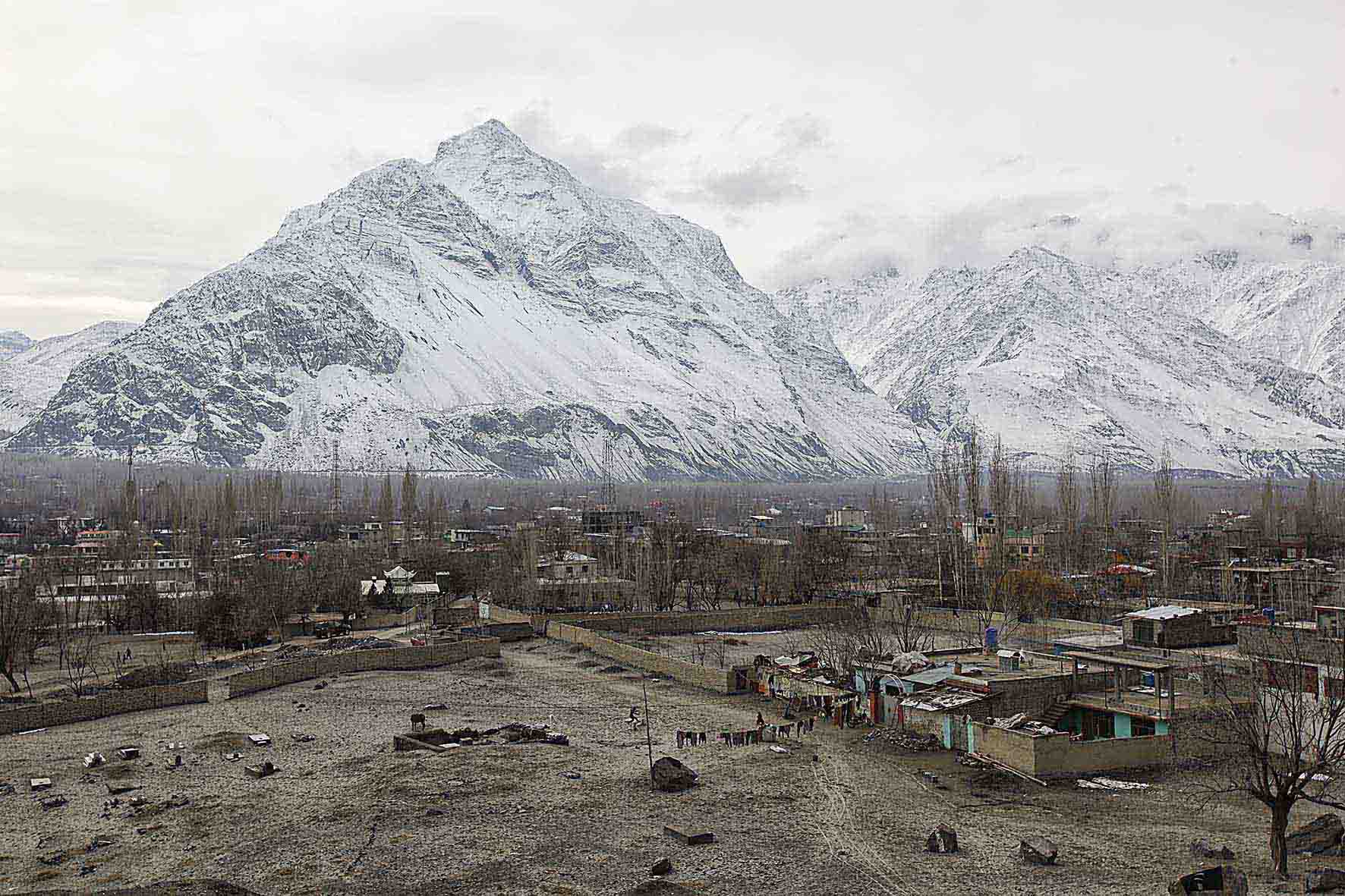
Skardu in Baltistan (Pakistan)
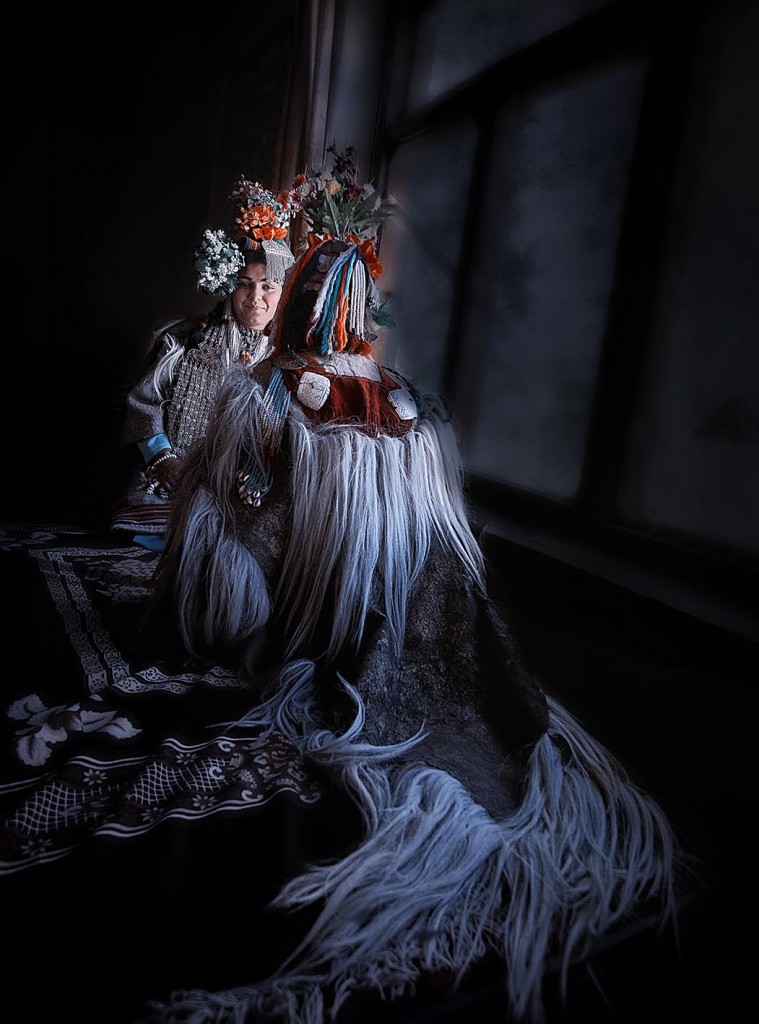
Dard tribes reside in a few villages en-route from Leh to Baltistan
Having conquered Baltistan, General Zorawar Singh returned back to Leh via the Khapalu – Chorbat – Nubra valley route. Nubra valley is a high altitude cold desert at 10,000 feet. It is on the historical silk route.
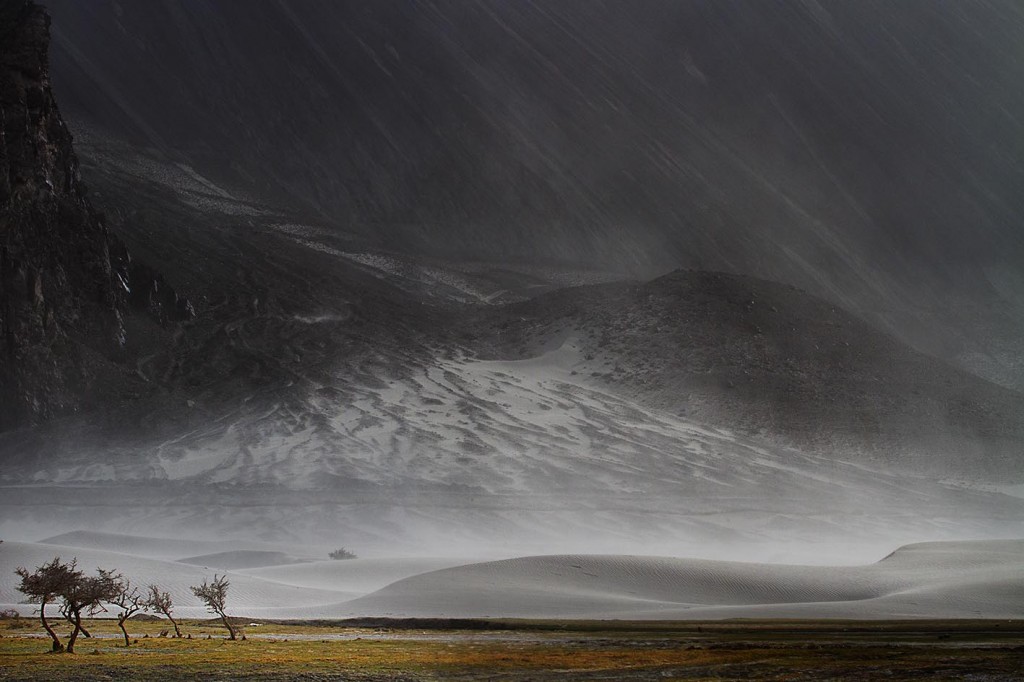
Nubra Valley, Ladakh
In 1841, General Zorawar Singh turned his attention to the roof of the world, which led him to Western Tibet. Crossing Pangong lake at 14,300 feet, at the Ladakh – Western Tibet border, he travelled via Guge kingdom, Tholing, Purang to Mount Kailash and Mansarovar.
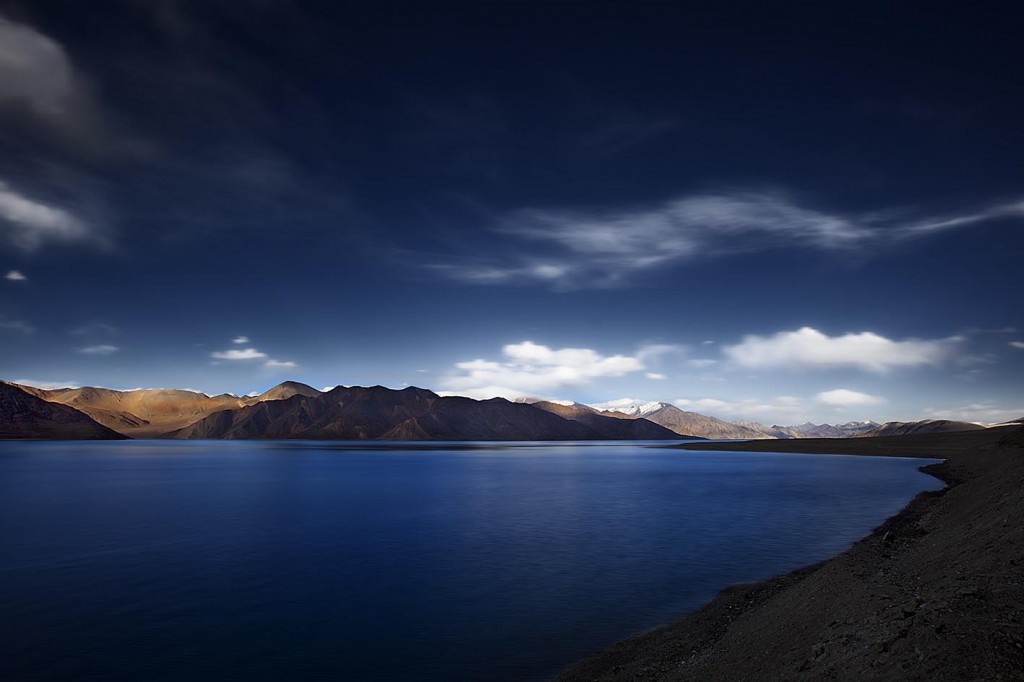
Pangong lake, Ladakh
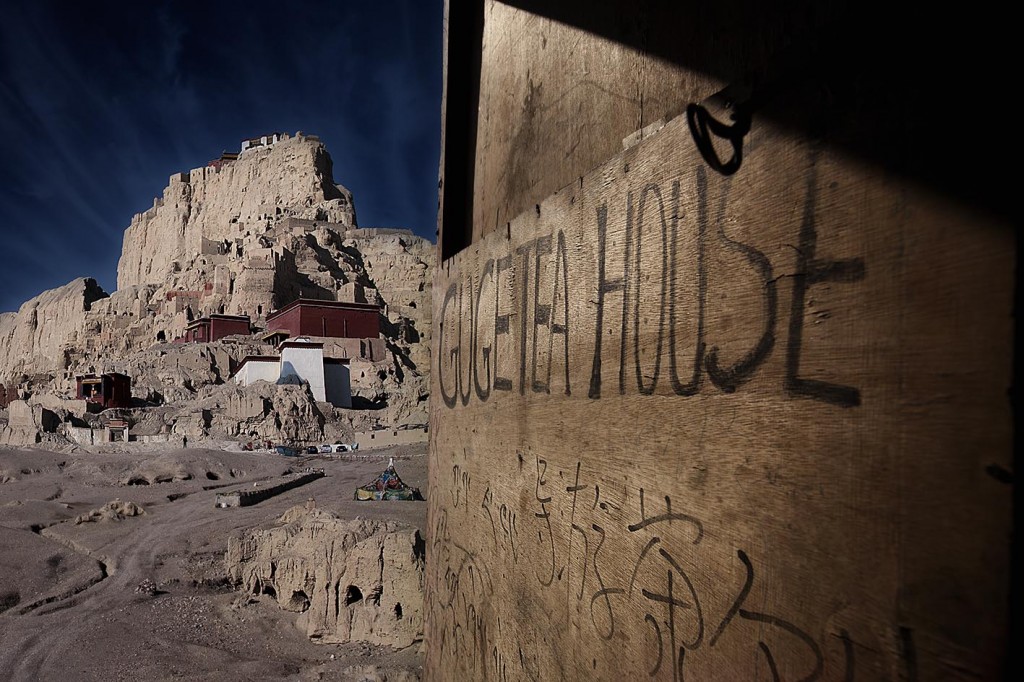
Guge kingdom, West Tibet
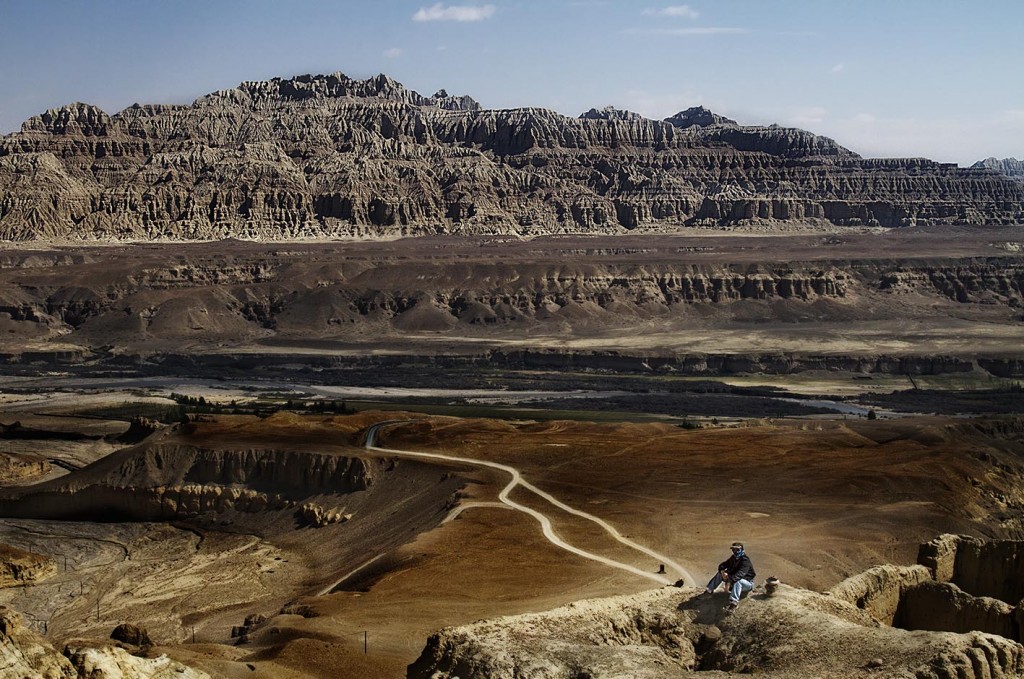
Flow of Sutlej River at Guge kingdom, West Tibet
At Purang Valley, which lies separated from Mansarovar by the Gurla Mandhata range, his forces climbed the Gurla pass and reached Dogpacha. Here they were caught totally off-guard by the Tibetan forces. A fierce hand to hand battle resulted in the victory of Zorawar Singh, who captured the Tibetan army “Colors” flag, which till today lies in possession of the Indian Army.
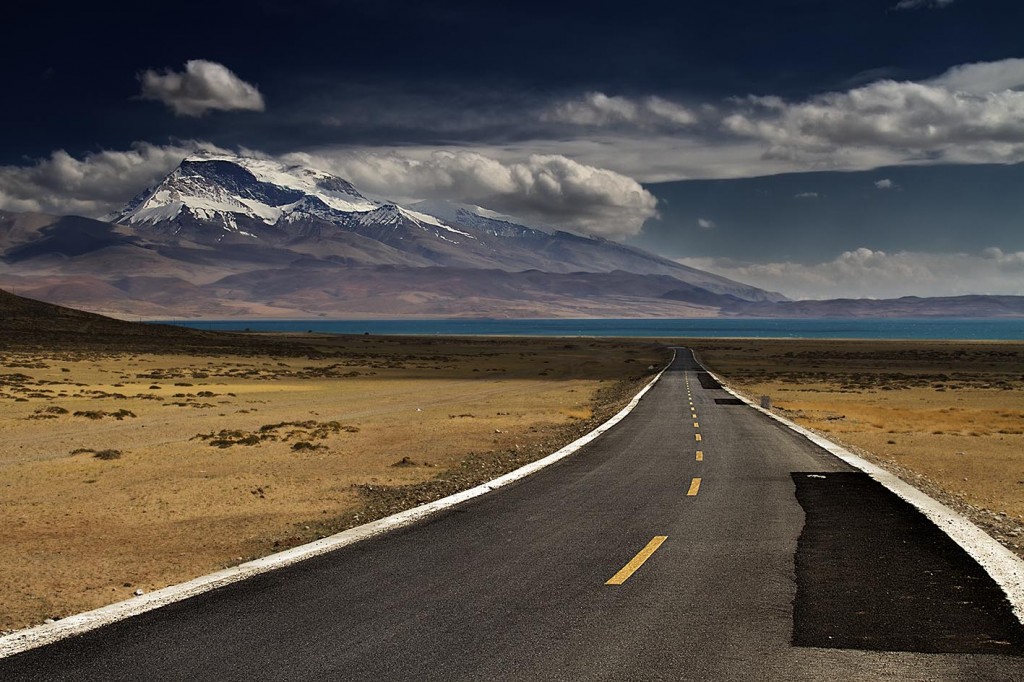
Gurla Mandhata range, Tibet
After the visit to Mount Kailash and Mansarovar, General Zorawar Singh’s army turned South towards Taklakot, where a battle was fought with the Tibetan forces at the high altitude Mayum pass (17,000 feet).

Lake Mansarovar & Mount Kailash, Tibet
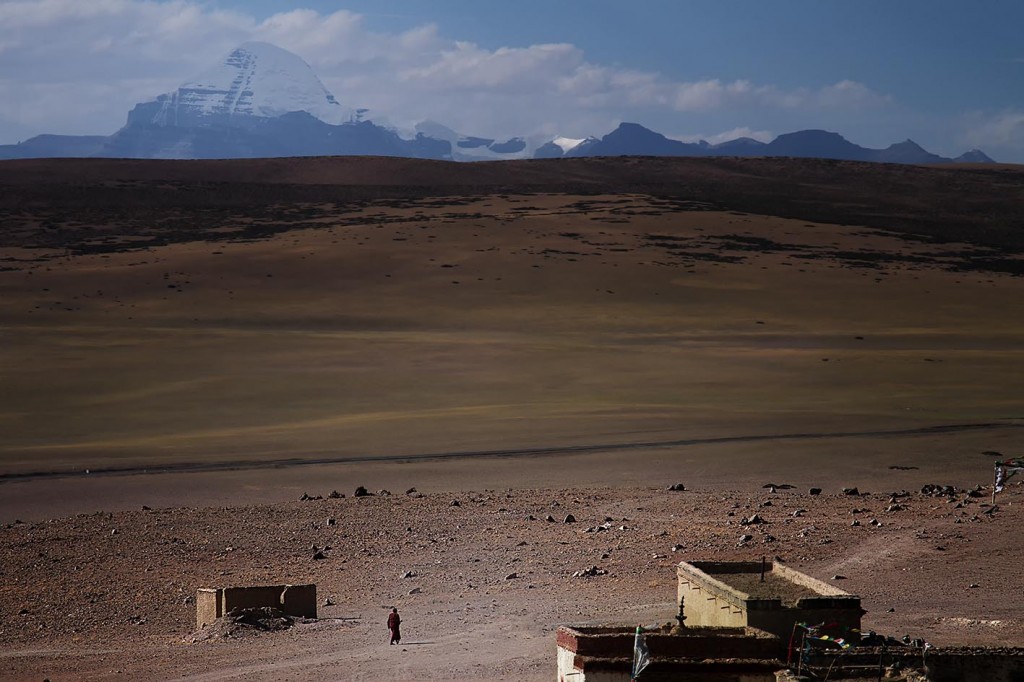
Lake Mansarovar & Mount Kailash, Tibet
In an operation lasting three and a half months, some 550 miles of Tibetan territory was captured by General Zorawar Singh.
In July 1841, GT Lushington, the British Commissioner of Kumaon in India learnt that extensive territories in Tibet have been captured. British were alarmed and decided to send Captain JD Cunningham to the Sikh Darbar in Lahore to discuss the matter as this was seen as a threat to British India. Lahore Darbar remained evasive of Cunnighams queries thus letting General Zorawar Singh have more time to complete his task.
By now the winters were fast approaching. General Zorawar Singh decided to move to Tirthapuri and prepare for the offense in the coming summer months.
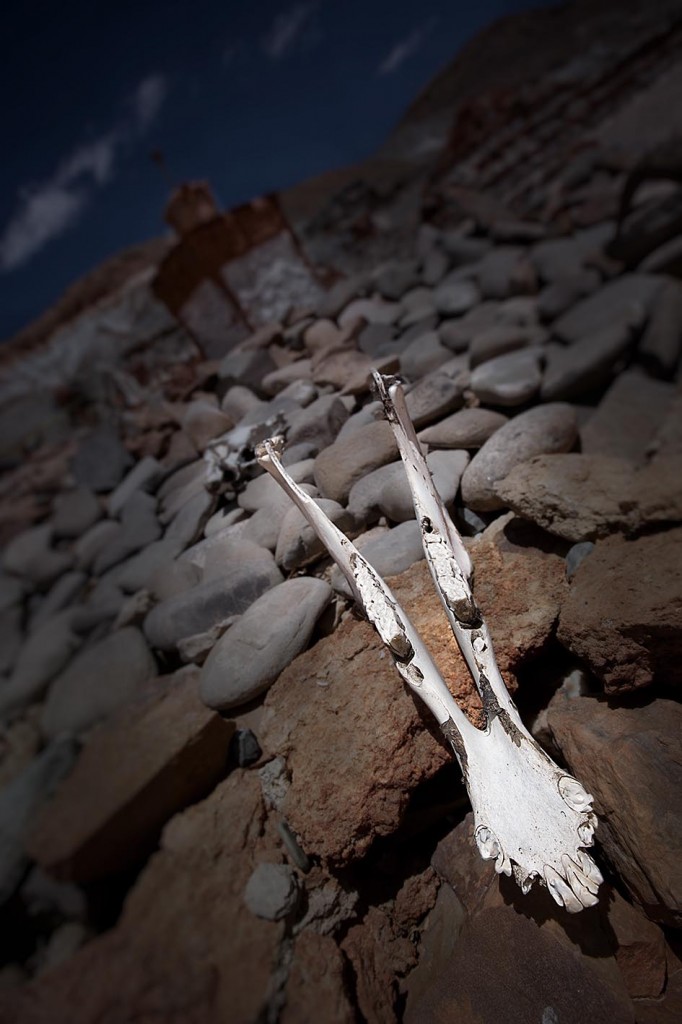
Tirthapuri, Tibet
While the General had everything going his way as he had sealed the Mayum pass before arrival of winters but he made a small miscalculation. He did not take into account that forces from Lhasa could also reach via the Matsang pass, which was South of Mayum pass and was negotiable even in the winter months. This was a strategic mistake. In the peak winter months, as General Zorawar Singh’s forces became complacent, the Tibetan forces attacked through Matsang pass and caught them off-guard. High altitude battle in the peak winter months against a large Tibetan force was fought. During the night the weather turned against them with a heavy snow storm. Many soldiers were frost bitten and were dying due to insufficient clothing.
On 12th December, 1841 General Zorawar Singh was hit by a bullet on his left shoulder and died at Taklakot. Even though the morale of the forces was broken, it was only by January 1842 that the last fortifications, under the command of Basti Ram (military officer of General Zorawar Singh) abandoned their positions. With him, many soldiers crossed the Tibetan plateau but only 242 of them reached Askot in Kumaon, which was in the British India territory. From here they continued the journey to Ludhiana and entered the Sikh kingdom to the east of river Sutlej.
General Zorawar Singh’s severed head was carried to Lhasa where it was placed at a thoroughfare for public viewing.
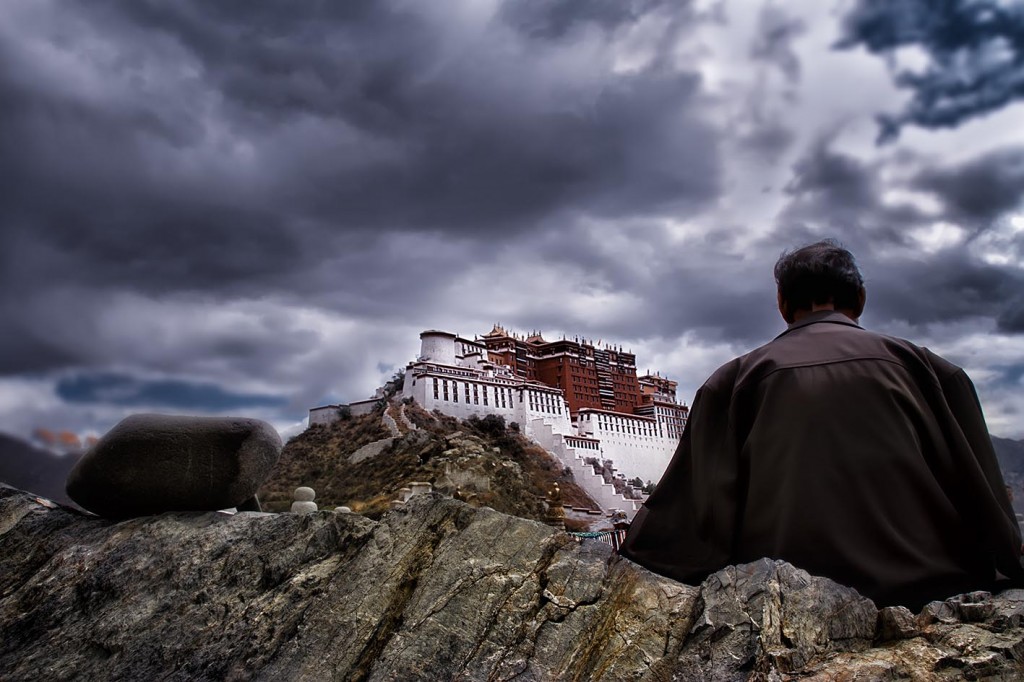
Potala Palace, Lhasa, Tibet (General Zorawar Singh’s severed head was placed outside for public viewing)
The Tibetans however also recognized the valor of General Zorawar Singh and built a Chorten (Cenotaph) at Taklakot in his memory. Even today, the Tibetans call it “Singh ba Chorten” or the Cenotaph of the “Singh Warrior”.
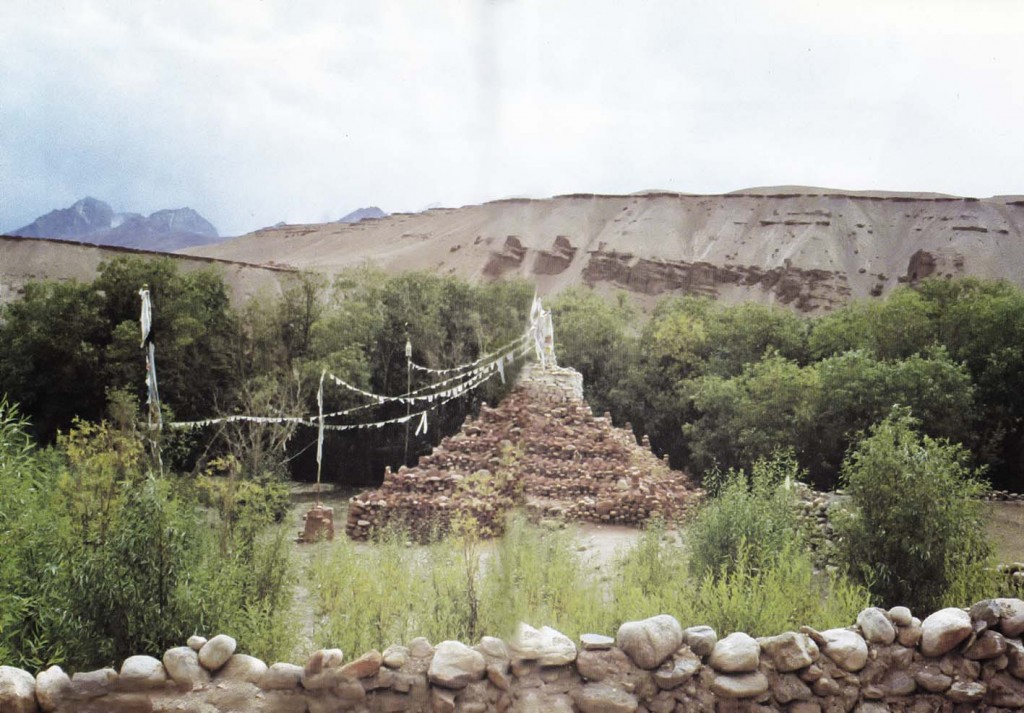
‘Singh-ba-Chorten’ the cenotaph of the Singh warrior at Taklakot, Tibet
About the soldiers who were taken into captivity, Tsepon W. D. Shakabpa, who served as Tibet’s Secretary of Finance from 1930 -1950, writes on page 243 – 244 of his book, TIBET – A Political History : “Over three thousand Sikhs were killed in the course of the foray. Seven hundred Sikhs and two Ladakhi ministers were taken prisoners. The remainder of the defeated army fled…. Those prisoners wishing to return to their country were allowed to do so….. One third of the Sikhs and Ladakhi prisoners elected to remain in Tibet. The Sikhs were resettled in warmer regions of Southern Tibet by the government and many married Tibetan girls. The Sikhs are known to have introduced the cultivation of apricots, apples, grapes and peaches into the country.”
The pistol of General Zorawar Singh is a part of the private collection of Sukbinder Singh in UK.
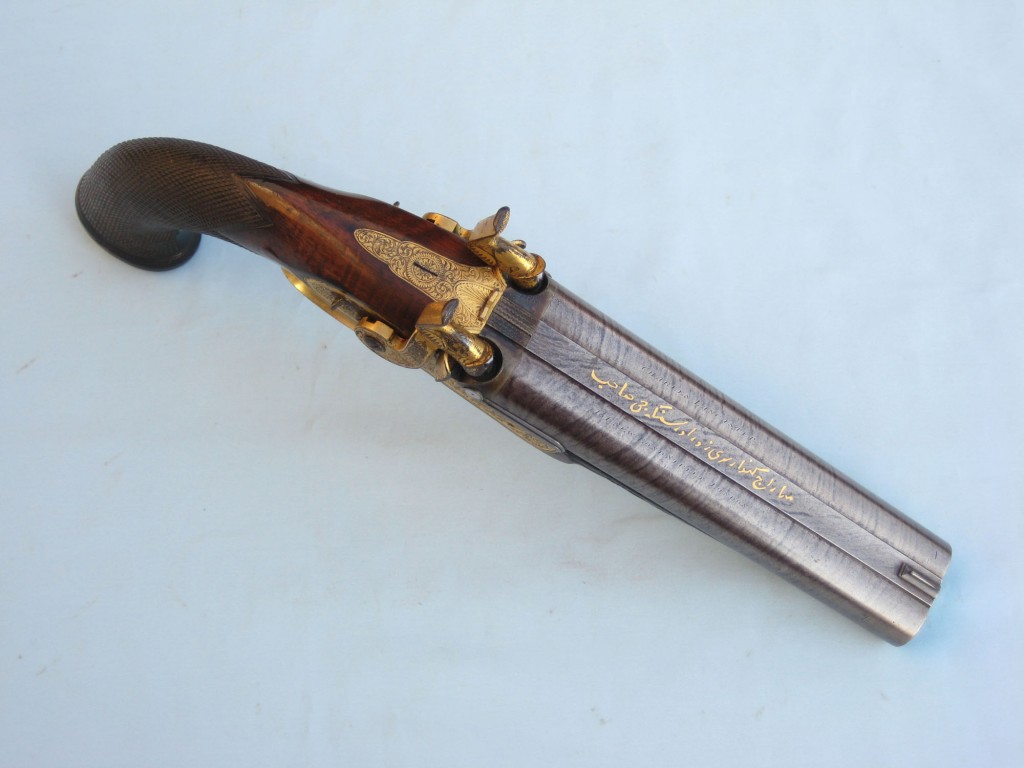
General Zorawar Singh’s pistol in a private collection in UK
So what about the skeletons at Roopkund lake? Are these of the retreating soldiers accompanying Basti Ram, who may have lost their way and perished at the high altitude?
A recent expedition to Roopkund lake by a National Geographic team retrieved about 30 skeletons and their carbon dating has placed the time of mass death to 9th century AD. While the mystery of Roopkund, through scientific investigation has negated it’s linkage to the Tibet expedition of General Zorawar Singh, but a curious conversation with Mr. Vaishnav at The Doon School in the year 1983 has sub-consciously led me to these remote places, tracing the footsteps of General Zorawar Singh.
A journey performed over thirty years has made me realize that ‘not all who wander are lost’.

Comments(134)
Manpreet Singh says:
September 25, 2013 at 12:05 AMAmazing work, beautifully explained. General Zorawar Singh puts me to shame – we have wasted this life !
Keshav says:
July 5, 2014 at 10:33 AMIndeed, on feels so small against the daring of Zorawar Singh.
Kamal says:
December 25, 2015 at 10:22 AMThis journey of 30 years giving glimpse of greatness of Gen Zorawar Singh is amazing. I had a chance to serve in the areas through which Gen Zorawar Singh’s Army had passed. I still wonder how did he manage the administration. I commanded my unit during Kargil War in 1999. I know how difficult is it to fight in this rugged terrain. General Zorawar and his Army deseves the highest honour. Our younger generation must know of the achievements and should be proud of such brave sons of the soil.
Jasbir Bhatia says:
July 3, 2020 at 5:04 AMThe current leaders of India are not interested in teaching the history of Sikhs and their contribution to India.
Lt Col P L Prashar (Veteran) says:
November 10, 2020 at 10:09 PMMy parent Unit FATEH SHIBJI(4 JAK RIFLES),fought under Gen Zorawar Singh in 1841,defeated the Chinese,captured Chinese flag (MANTALAI),still with my Unit.
PRITPAL SINGH says:
April 25, 2019 at 12:02 PMsir let’s all sikhs join hands to gather ,save our glorious Sikh history and the same must be passed in without distortion to our young generation , undoubtedly sikhs are diamonds in the crown of mother India .
Satluj Das says:
June 19, 2020 at 11:58 PMAmazing exploration investigation and documentation especially for IndianS to learn their history and geography.
It is amazing how great visionary of Ranjit Singh, Gen. Hari Singh Nalwa and Gen. Zorawar Singh, ended invasions from Central Asia, Iran, Afghanistan, their sacrifices to secure Himalayan borders.
This was done by uniting people from across Punjab, NWF, Kashmir, Ladakh, and Himachal regions in secure way under Khalsa Raj to protect India. Thanks for educating us. This work needs to be published in all Indian languages across India.
Col narendra says:
June 28, 2020 at 8:44 PM..and what did our power hungary politicians did to this great legacy of Great sikh king and gerefals …devided into 2 in 1947 , then 3 in 1971 …why was pak was not dissoleved and asingle country was formed to correct erroe of 1947 ?
Jasbir Bhatia says:
July 3, 2020 at 5:08 AMYou are right. Our leadership of Nehru Gandhi dynasty ruined India.
Dinesh Malkani says:
June 20, 2020 at 2:18 AMTruly
Harpreet Singh says:
June 20, 2020 at 11:02 AMGreat effort to explore our ancestors bravery n enthusiasm to led the world n expirations for us nd Future generations to feel proud what our forefather’s hv gvn to the country..pls also make some efforts to gv it wings on creative movie making so that such a bravery shouldn’t hide behind the paper only n world should know….rgds
Ajay Nihalani says:
June 29, 2020 at 3:26 PMGeneral Zorawar Singh n Hari Singh Nalwa r stuff of legends who unfortunately havent yet been given the desired recognition in Indian history.
His bust is at display at the Army museum at Leh.
Amit says:
September 25, 2013 at 12:29 AMAwesome! Fantastic account & Pictures are just great as always…
Just wondering ..Is there a sikh population in Southern Tibet now as well
Sukhjinder Singh says:
June 20, 2020 at 1:32 PMThoroughly researched compilation. I had a chance to visit some areas and know how difficult is it to fight in this rough rocky terrain.
Proud of such brave sons of the soil. Yet so little is known about him. Thanks
Chandeep says:
September 25, 2013 at 1:35 AMvery nicely put
would love to get the details of the journey
makes me want to go there
Karamjeet Singh says:
September 25, 2013 at 3:11 AMA wonderful History Lesson.I had a vague knowledge of the expedition and it was considered futile,but now I know the resultant geo-political advantage The Sikh General left behind for India.India needs to honor the General in a befitting manner.Thanks Amardeep for the photos and wire up.Good going…
Arvinder Singh says:
September 25, 2013 at 6:36 AMThe service you are doing is just awesome. If possible can you put up a map trailing the path Gen. Zorawar Singh took. Articles from the last so many weeks all linked up nicely into this journey. Thanks for sharing the history with everyone. Pass this to the Sikh Digital Library project so it can be preserved and used for research.
Amardeep Singh says:
September 25, 2013 at 8:11 AMAmit,
On your question above.
Presently there is no Sikh population in Tibet. If what is written in the text of the earlier Tibetan Finance Minister’s book, as quoted in my blog, is true, then either the Sikhs have assimilated in the local population or due to harshness of environment, have moved back to India. Surely after the Chinese Cultural revolution in 1950 and thereafter the Chinese occupation of Tibet, there would have been no choice but to move back to India.
In my travels to remote Western areas in Tibet, I did homestays and here the older generation could still speak some words of pahari, which is a mix of hindi and punjabi. The language was used freely before 1950s, when trade used to happen through Spiti and Ladakh regions of India.
Amardeep
Neeraj Mishra says:
August 1, 2016 at 2:22 PMWow, Loved the story Mr. Amardeep. Stumbled on your article while researching more about the general who is known as the Napoleon of India, yet so little is known about him. Thanks for writing this beautiful piece !
Harawant Singh says:
September 25, 2013 at 9:54 AMHistory re-written. Syabus on research and superb photography.
Mandeep says:
December 26, 2015 at 10:34 AMHello Mr Amardeep,
Great reading your article. I am Colonel Mandeep Dhillon, Commanding the Battalion that was involved in this great expedition. We still have the flag captured in the expedition – The Mantalai Flag.
Would be great to interact with you as it would help us enrich our history. My email is attached.
Regards
Amarpal Matharu says:
September 25, 2013 at 11:12 AMAmardeep,
Great research, photography and concise narration on Sikh history. We are very proud of you!
Amarpal
PP Singh says:
September 25, 2013 at 12:45 PMBeautifully articulated historical fact leaves me mesmerized.
Dhiraj says:
September 25, 2013 at 1:34 PMWhat an incredible journey! You have traced Gen Zorawar Singh’s footsteps aided by awesome pictures amazingly well! Thank you Amardeep for this fabulous history lesson…wish history as a subject can be made so interesting at schools!
Col. Harindar Singh Bedi says:
September 25, 2013 at 10:43 PMThis has been passed on to me by my son, Hapreet.
My compliments on a very well-researched piece on General Zorawar Singh. One cannot but marvel at the ‘audacity’ shown by Maharaja Ranjit Singh through his generals (including Hari Singh Nalwa). Well led, the Sikh army could overcome stiff resistance in such inhospitable territory. Can one imagine today that the Sikh kingdom’s pennant once flew over the roof of the world?
Col. Harindar S. Bedi
Rajinder Pal Singh says:
September 25, 2013 at 9:49 PMA beautiful historical account so well supported by excellent photographs speaks volumes of your talent, Sardar Amardeep Singh ji. May Waheguru, the Akalpurkh, be with you, always. Gurfateh.
Jaspal Sehdave says:
September 25, 2013 at 11:20 PMYou are truly blessed to visit such rare places and not only revisit history but re-account it and share it with us as if we are there to see it for ourselves …. Great!!
Nargis Seemab says:
September 26, 2013 at 2:29 AMI am Durrani Afghan, but got married to a sooraj bansi rajput, Shahi family member. we both are history lovers and like to read and discus such topics. we both are proud on our origins. My husband always admire Ranjeet singh.
i have a topic Zorawar singh for today discussion with my husband.
thanks for sharing.
JOhn Arifin says:
September 26, 2013 at 11:12 PMAmardeep, I have been hearing bits and pieces of the story from you all this while.
Now the complete story with illustration. Well done and well researched with beautiful images.
Uma says:
September 27, 2013 at 12:56 PMGreat work! I keep reading South Indian History of Chola Pandya and Pallavas… first time, I found history about North India interesting….. very well written article with good photographs. Would love to read more on Mount Kailash and Mansarovar..
Anand Swaroop says:
September 28, 2013 at 9:43 AMGreat pictures and wonderfully written concise article. I had a chance to visit Tibet twice and also the museum at Leh, but was not aware of the completely researched life of Gen Zorawar Singh. Would like to read more about his life and possibly retrace his route of travels.
Mohindra Chadha says:
October 3, 2013 at 3:11 PMExcellent pictures and the narration.
The National Geographic carbon -14 dating of 30 skeletons places some doubts about the mass death. These skeletons must be from an other era. More research needs to be done to clear the mystery!
Arjit Mahal says:
October 4, 2013 at 7:56 AMAmardeepji – I have become your fan. While I have read a lot about Sikh Raj, I knew very little about Ge. Zorawar Singh’s campaign. You have made this part of the history come alive for me. Best wishes
Ramandeep Singh says:
October 5, 2013 at 10:46 AMWhat a great piece of history. Never in south Asian sub continent any one dared to conquer other side of Himalayan mountains deep into Tibet before Sikh Raj.
So wonderful to read about Sikh warriors that actually made it happen.
Thanks for research.
punjabibolo says:
October 5, 2013 at 1:26 PMwonderful achievement man… god bless you very soon will published your website and articles in my blog Thanks
Birender Singh says:
October 6, 2013 at 10:46 AMVeerji, you are doing marvelous work but i think if you can share your findings with other similar scholars having interest in Sikhi History like Sukhpreet Singh Udhoke (http://itihas.net/main/index.php?option=com_content&view=article&id=32&Itemid=94) or Punjab Digital Library, it would be wonderful. “Hoye Ikattar milo mere Bhai”
Andrew Johns says:
October 7, 2013 at 2:27 AMStunning photography. Interesting research. Glad to see a seed planted when you were 17, gestate and flower over the years.
PS: a small nit. I don’t think Ranjit Singh or the Sikhs of 17th and 18th century were motivated by the same nationalistic fervor of protecting the “Indian sub-continent.” Nationalism is a relatively recent phenomenon. And India as we know it today, never really existed. Most maps of Ranjit Singh’s period or pre-Ranjit Singh identify the “Panjaub” as an area distinct from “Hindoostan” (India). Ranjit Singh was motivated, as any sensible ruler would by the welfare of his state, not Indian or even Sikh nationalism. We’d be projecting current biases back on a different time, a common instinct when analyzing history.
PKS Bedi says:
September 27, 2018 at 12:49 PMWhile Maharaja Ranjit Singh and his Generals acted in the defence and the betterment of the people at large, irrespective of boundaries or borders, and to protect them against marauders; the British only came to plunder the wealth of the land, for the Crown. Period. And wherever they found a bonding or strong unity among the natives, went about ruthlessly and slyly, to break those bonds …. any when they left, they made sure it was a mangled mess.
Amardeep Singh says:
October 7, 2013 at 8:33 AMThanks Andrew Johns,
Happy that you found this piece interesting.
Indian subcontinent, before the British bought it under a single leadership, did exist fragmented into small kingdoms. However there was a common cultural, religious and linguistic (minor variations of North Indian languages) thread that integrated the people to freely move between the states and contribute to each other. If not for this aspect, why then would Maharajah Ranjit Singh have contributed Gold to Vishwanath temple in Varanasi? Why would the Sikhs have returned the valuables to the Jagarnath Temple in Puri, which they recovered from the retreating plunderers from Afghanistan, who came to the sub-continent to loot? Why would Maharajah Ranjit Singh provide Sikh soldiers to the Nizam of Hyderabad? Why would he build a memorial Gurudwara at Nanded in central India where Guru Gobind Singh left this world?
I can go on with the list of whys? However the point remains that the many states that made the Indian sub-continent had a commonality and were also distinct from each other.
The contribution of Maharajah Ranjit Singh to the India sub-continent being that before the Sikh kingdom was annexed by British, he had succeeded to expand it to Peshawar in East and in North to Baltistan and Ladakh. If not for this expansion, the India of today would not be sitting strategically on the high altitude passes of Ladakh, which could have fallen in the Chinese territory after their occupation of Tibetan plateau.
The story of India is very complicated, Andrew. It needs a holistic approach to understand the various dynamics in play.
Milind Chitale says:
May 16, 2017 at 1:42 AMVERY PERFECTLY PUT!
It is sad though that we still praise the Britishers and never teach such local history as it may create a ‘TRUE’ mind that politically may not be acceptable to the ‘Democracy’ of India!
S Robertson says:
June 25, 2020 at 9:44 PMNo mention of Dogra soldiers??? Zorawar Singh was a Dogra Rajput. The Army was largely Dogra.
Gurvinder Singh says:
November 3, 2020 at 1:04 AMIlluminating & further thought provoking.
Thank you for all your wonderful posts, articles , photographs, essays and analysis.
Intellectually and emotionally rewarding.
Lalli Brar says:
October 7, 2013 at 9:23 AMGreat thank you
varinder singh jawanda says:
October 7, 2013 at 10:31 AMAbsolutely magnificent narration and presentation of a largely unknown historical event .. very impressive illustration and relevance
Uday says:
October 7, 2013 at 11:39 AMThe boundaries of India, the separation of India and Pakistan, and how the British seemed to have made their decisions, all appear in a whole new perspective now.
Where is all that bravado and sense of adventure gone amongst us?
Thank you for a wonderful account of Gen Zorawar Singh, Amardeep.
Savithri Kalidhas says:
October 7, 2013 at 9:56 PMWhat a wonderfully written piece and the pictures just speak to you. It was like watching a documentary. Thank you for bringing such heroes into the limelight.
Narinder says:
October 9, 2013 at 9:10 AMThanks to my friend Alvinder for sharing this.What an amazing journey into the pages of history through an equally amazing photography.
Sanjay Pal Singh says:
October 9, 2013 at 7:20 PMMy Compliments Amardeep Ji! Your narration of facts literally brought tears of pride in my eyes. Please keep up this great work, i will kepp following for sure.
Chitrang says:
October 9, 2013 at 8:08 PMExcellent narration, nice camera work. Told the history about Zorawar singh, Indeed a great warrior, but I guess Rooopkund mystery wont be solved
Abhishek says:
October 14, 2013 at 11:29 PMVery well written piece.
Krishnan V says:
October 15, 2013 at 1:07 AMAmazingly well researched and wonderfully narrated . kudos !
Inderjeet Singh says:
October 18, 2013 at 4:38 AMAwesome photos. I knew the story except from the extract from Political History of Tibet. The history with stunning photography is simply out of this world! I am interested to know about the man, Zorawar Singh. Could you give some pointers? Dogra/Hindu website seem to suggest he was a Hindu Dogra. Some say he is Hindu Rajput. Are you aware of his background?
Amardeep Singh says:
October 19, 2013 at 11:47 AMInderjeet,
It does not matter what faith Zorawar may have been born in. He was though born in Kahlur, in current Himachal Prades, which in those days was a part of Punjab. The reign of Maharajah Ranjit Singh was very liberal and his army made up of European, Hindu, Muslim and Sikhs. They collectively fought for the defense and expansion of his kingdom, as his employees. Zorawar singh was a General of Ranjit Singh’s army and that’s what matters as he never differentiated the ranks on account of religion.
In the reign of Maharajah Ranjit Singh, virtually all his generals had started supporting beards and turbans, the visible Sikh forms. So much so that check the picture of his artillery commander, Sir Alexander Gardner, in a full sikh appearance, though he was a European.
From the Tibetan history perspective, the attack by Zorawar’s forces is mentioned in their history texts as an advance by Sikh kingdom. It is therefor important to read history from the perspective of the ones who were being attacked.
Also note that the British on hearing about the advances of Zorawar Singh in Tibet, sent their officer, Captian J D Cunningham to Lahore darbar to find out about this advance. This means the British saw the leadership under the Maharajah based in Lahore, who at that time was Sher Singh as Ranjit Singh had died.
So the supreme leadership was that of Ranjit Singh and the rulers thereafter that approved of the advances to Baltistan, Ladakh and Tibet.
Ravinder Singh says:
October 21, 2013 at 1:14 AMAmazing history and photography! Wish history books were this interesting. Appreciated your effort.
Subhash Kale says:
October 24, 2013 at 12:24 PMScientists from Deccan College, Pune, India made the documentary for National Geographic
Mohinder Gulati says:
November 13, 2013 at 7:21 AMMy compliments to you for exploring the segment of the Sikh history that is not very well known or published unlike the events relating to Maharaja Ranjit Singh.
Zorawar Singh was a great and a selfless general!
dr gp singh says:
December 12, 2013 at 12:25 AMHave read this earlier too.
Such should find a place in our history books in schools. Great effort.
Inderjit gill says:
December 22, 2013 at 12:29 PMBreathtaking photography, and incredibly well written account .
Gurpreet Singh Anand says:
January 3, 2014 at 11:29 PMWhat an insight into the closed ,forever,chapters of Sikh History where historian have toed official lines be it British or Independent India.You have done a commendable job in unearthing long forgotten saga I suggest you to check historical and official records kept in Panjab Archives in Lahore as Lahore was Ranjit Singh’s capital and official records lithographs of his time are best preserved there .I will delve more ,and if I can will share what I find in printed works .Meanwhile do update me whatever new you uncover in this tryst .Without saying , you have Blessings from Up There to do this selfless job for coming generations .
Gurjender Singh says:
January 12, 2014 at 1:01 PMToday I was watching Sikh Channel TV from UK, Dr. Sukhjeet singh mentioned that there is documentary is being made and will be released about General Zorowar Singh. When it will be released and how I can get a copy.
RS RAJPUT says:
January 13, 2014 at 10:03 AMIt makes us very proud to learn about our illustrious ancestors. We never knew that our native army had the capability of Hannibal who crossed the Alps with elephants or Napoleon who marched his troops from France to Moscow. We can be proud of Gen Zorawar Singh. It is hoped that the Indian Military Academy and the Officers’ Staff College will do further research on our native military prowess and genius and make it compulsory reading in the study of military history.
Ajnauda says:
January 14, 2014 at 11:55 PMThanks AmarDeep Singh
Daljinder says:
January 15, 2014 at 5:31 AMThanks for sharing … Great work
ਬਲਵਿੰਦਰਪਾਲ ਸਿੰਘ ਖਾਲਸਾ says:
January 15, 2014 at 5:38 AMਜਰਨੈਲ ਜ਼ੋਰਾਵਰ ਸਿੰਘ ਦਾ ਸੰਘਰਸ਼ਮਈ ਜੀਵਨ ਪੜ੍ਹ ਕੇ ਬਹੁਤ ਮਾਣ ਮਹਿਸੂਸ ਹੋਇਆ। ਕਦੇ ਅਸੀਂ ਵੀ ਖਾਲਸਾ ਰਾਜ ਦੇ ਮਾਲਕ ਸਾਂ ! ਤੇ ਸਾਡੇ ਮਹਾਰਾਜਾ ਰਣਜੀਤ ਸਿੰਘ ਨੇ ਤਿਬਤ ਤੱਕ ਖਾਲਸਾ ਰਾਜ ਕਾਇਮ ਕੀਤਾ। ਗਮਗੀਨ ਕਰ ਦਿਤਾ ਖੁਸੇ ਹੋਏ ਰਾਜ ਦੀਆਂ ਯਾਦਾਂ ਨੇ। ਸ਼ਾਇਦ ਕਦੇ ਫਿਰ ਵਾਹਿਗੁਰੂ ਜੀ ਕਿਰਪਾ ਨਾਲ ਖਾਲਸਾ ਰਾਜ ਦੀ ਪ੍ਰਾਪਤੀ ਹੋਵੇ। ਮਹਾਨ ਜਰਨੈਲ ਜ਼ੋਰਾਵਰ ਸਿੰਘ ਨੂੰ ਹਜ਼ਾਰਾ ਸਲਾਮ ਤੇ ਸੈਲਿਊਟਸ !
Majhail Singh says:
January 15, 2014 at 12:48 PMUndoubtedly S.Amardeep Singh’s work is marvelous and a mile stone in The Sikh History .Despite of I being student of Sikh History in my post graduation , I never read about Gen. Zoravar Singh’s Expedition to Tibet in such a way as now from this Article ,It means Sikh history from the Time of Guru Nanak Dev ji requires afresh look as is being done by S .Amardeep Singh . Thanks for the photos shared to understand how the expedition was a tough job.
Raj sekhon says:
January 15, 2014 at 3:31 PMFeelings proud
H.S.Dhami says:
January 15, 2014 at 5:43 PMA great work and sincere effort by Amardeep Singh to trace the Sikh History.Very informative and makes me feel proud .
Harinder bir singh jaspal says:
January 20, 2014 at 6:41 AMAmazing. I have tears in my eyes what a rich history we have. Thanks to S. Amardeep Singh ji Keep up the good work. I am sure there is more to discover.
LT COL RSMODGIL says:
February 2, 2014 at 1:48 PMu have done a very good research in our militaey history.
It is commendable, keep it up.
alittle more resarch can lead to a book on tne genral.
LT COL RSMODGIL says:
February 2, 2014 at 1:50 PMgod job.
convert it into a book,
shahid says:
February 24, 2014 at 8:41 PMVeer ji you are doing very grate God Bless you and keep it up with all your best…Shah
https://www.facebook.com/savehistoricalplacesofpakistan
shashi rai says:
June 24, 2014 at 3:17 AMBrilliant, being a history buff, this is excellent addition to my knowledge.
i have read the history about Maharaja Ranjit Singh and his great general Nalwa. did’t have this much information about Zorwar Singh.
thanks Again.
Amrinder says:
July 31, 2014 at 7:10 PMGeneral Zoravar Singh was hindu paharia and not the sikh as majority of the readers misinterpret . He was employee of Lahore Durbar and the success of Maharaja Ranjit Singh’s Lahore Durbar was due to secular approach as most of the generals were muslims and hindus .
Amardeep Singh says:
November 13, 2015 at 10:00 AMWell Amrinder, It was Ranjit Singh’s secularity and greatness that he incorporated talent, not basis on religion. It is our current generations myopic understanding that we try to segment everything into religion. In this blog, I am not mentioning anything about Zorawar’s faith and the subject is merely about the greatness of a General who was an employee of the Lahore Darbar of Ranjit Singh.
Antlia BC says:
December 16, 2015 at 6:44 AMDo you have any support information which witness this, Jorawar Singh was a born Sikh which means he was born in a Sikh Family. Yes, he was born in Kangra, but in a Sikh family not any Hindu or Rajput family. Also he was recruited as a soldier in Khalsa Army during Annexation of Multan where he made excellent contribution to victory and later he was sent to Kangra to help then King of Kangra from enemy attack- here again he showed excellent war fare techniques and bravery, so Ranjit Singh made him an in-charge of khalsa troops in Himachal. Also please note Jorawar Singh had 40 soldiers as guards with him who were all from Khalsa Army Lahore. He never worked for any Dogra or Hindu Kings, He started his career from only Sikh Army and always remained with Sikh Army; because he helped a lot of Khalsa army allies in Himachal people confuse him as part of Dogra army. Also please note: He was well aware of backstabbing of Dogras, and therefore always kept them unaware of his missions and it is only after death of Ranjit Singh, Dogras came to know about the real mission of Jorawar Singh after annexing Tibet which was to defeat and push Britishers out from India by coalition with Gurkhas. When Dogras learned about this they backstabbed the hole nation and leaked this information to Britishers and also with the help of Britishers ambushed Jorawar Singh and his army.
Zoom says:
July 31, 2014 at 10:19 PMI hardly drop responses, but I read a ton of comments on this page Thirty years – In search of General Zorawar Singh
(1786 – 1841) | Amardeep Photography.
bikram says:
September 30, 2014 at 8:49 PMBrilliantly Expressed and photographed. Spell bound.
Ajay Tripathi says:
January 12, 2015 at 11:38 AMI would like to thank you about this interesting info which I never knew and am sure majority of people like me with interest in history would know.
I could walk through the path of Gen Zorawar Singh through your photographic evidences.
Really great!!
Keshav Singh says:
March 14, 2015 at 11:44 PMApparently General Basti Ram survived and next year there was another battle between these two adversaries ( combined Chinese and Tietan forces) in Chushul area. It seems that the Indian forces dammed a river and drowned the Chinese General. If true very ingenious. Please confirm.Agreement of eternal peace and friendship and love was signed thereafter between two adversaries only to be broken in 1962. Another interesting person from these areas to have gained lot of respect in Tibet is Guru Padam Sambav who spread Budhism in Tibet and is reportedly from Chitral in Pakistan.
Bhumesh Bharti says:
April 5, 2015 at 12:44 AMGreat…. The search for this article was begins in 1983 While trek to Roopkund.
rancy says:
September 26, 2015 at 4:41 AMNice work ….go ahead
Chamandeep Singh says:
October 20, 2015 at 4:22 AMNice work….Great…really informative…
rahul jamwal says:
October 26, 2015 at 7:12 PMdecedents of Gen. Zorawar singh and i am from that family
Antlia BC says:
December 16, 2015 at 4:39 AMGood Effort and great research, just a few more things to add:
The name of the general is Jorawar Singh not Zorawar Singh. Also the General Jorawar Singh was born in Kangra, but he is not from Rajput decent, no documentation supports the Rajput surname. His army was formed of 12,000 soldiers from Khalsa army (The army of Punjab, not Dogras) out of which 70% were Sikh Soldiers. General was well aware of Dogra’s back stabbing behavior, he kept Dogra’s away from this expedition and also never travelled through parts of Dogra kingdom to Ladhakh. Mehta Basti Ram was also an officer of Khalsa Army and not Dogra Army. Also the real purpose of this mission is not described in this story, the real purpose was to unite Gorkha kingdom with Punjab – so both Sikhs and Gurkhas unite and fight against Britishers and get rid of them from India. There was a secret treaty signed by then Punjab’s King – Sher Sing and Nepal’s King to untidily fight against Britishers. With the success of this mission both Nepali and Khalsa forces could have travelled to each others kingdom through Tibet and Ladakh, also after conquering Tibet Sihkhs would have gained access to Russia and Europe which was another huge concern for Britishers as this would have made their situation miserable not only in India but in Europe and England as well. On this mission General Jorawar Singh had planned mission to conquer Tibet in Three parts, Khalsa army had won the two already and they were all set to make the final attack, but the backstabber Dogras leaked the secret treaty to Britishers and sold the India to them. Dogras sent massage to General under name of King that King of Punjab wants to call off this mission and want this army back to fight with Britishers- Although King never sent any such massage, after that the general and his army was ambushed in a valley and was attacked from mountains-Khalsa army was already suffering from various high altitude deases and with frostbites still fought very bravely till their last breath. They got ambushed because Dogras leaked their route to Britishers and Britishers leaked it to Chinese King. Surely Dogras played a great role not in favor of India, but to sell and defat India against Britishers. And now they want to sell their backstabbing as heroic effort by publishing false and lie stories about their bravery. It is Dogras who sold India to Britishers; otherwise, Britishers had no courage to defeat and rule India. Beware of the false stories created by some hindu radical groups who are doing this with a sole purpose of acclaiming all the success of Sikhs so far.
hp says:
January 20, 2016 at 6:00 PMZorawar Singh Kahluria (1786-1841) was born in Kahlur State in Bilaspur, Kahlur, Sikh Misl. In reference to his legacy of conquests in the Himalayas including Ladakh, Tibet, Baltistan and Iskardu as General and Wazir (prime minister), he has been refereed to by historians as “Conqueror of Ladakh” and the “Napoleon of India”.[1][2]
He was born to in a Dogra Rajput family of Kahlur state in modern day Himachal Pradesh, they migrated to the Jammu region where, on coming of age, Zorawar took up service under Raja Jaswant Singhof Marmathi (modern Doda district). Zorawar Singh was employed by the ambitious Maharaja Gulab Singh of Jammu and was placed under the commandant of the Reasi fort (Bhimgarh fort). While delivering a routine message to the Maharaja, Zorawar told him of the financial waste occurring in the fort administration and boldly presented his own scheme to effect savings.
S Robertson says:
June 25, 2020 at 10:24 PMWhat a strange conspiracy theory narrative to deny Dogras their achievement…
Brig RK Sharma says:
December 24, 2015 at 6:51 PMA great coverage of the expedition . Would examine it greater detail. However I do not subscribe to the treachary theory.
Himanshu chaudhary says:
December 26, 2015 at 11:48 AMInfact Jorawar Singh was ranked as the no 1 General of all times.He was ranked so high because he achieved so much success with very limited resources and fought in such harsh terrains and climate which was favourable to his adversaries.His forces were defeated in Tibet by Chinese
Ram says:
April 18, 2016 at 4:16 PMVery well written article.
Makes me wonder what could have been achieved if Zorowar Singh and Hari Singh Nalwa were given the task of conquering Kabul and Ghandi!Two great gwnerals would have crushed the Afghans.
Ram says:
April 18, 2016 at 4:17 PMVery well written article.
Makes me wonder what could have been achieved if Zorowar Singh and Hari Singh Nalwa were given the task of conquering Kabul and Ghazni!Two great gwnerals would have crushed the Afghans.
sanjiv gangwar says:
May 20, 2016 at 11:37 PMthis is really amazing to know about our great gl. zorawar singh.as we come to know by reading that british rule was afraid of his advances, than i dont understand why this great hero is not been tought in our history books? i am really thankful to you sir for your research and for posting the story of our great gl. zorawar singh. jai hind.
AJAY KUMAR says:
July 12, 2016 at 3:50 AMLarger than life character of general zorawar singh and beautifully described by Amardeep ji…very informative chapter
thanks
Dr Navdeep singh says:
February 25, 2017 at 9:11 PMGreat !!!!!! best wishes to S Amardeep singh for his efforts done
Your research may become a mile stone for upcoming great history
Baljeet Singh says:
February 27, 2017 at 9:57 PMHats off to S Amardeep Singhji, great and courageous effort with All Mighty’s grace.
Wini says:
March 1, 2017 at 1:21 AMNice work. But just a correction he was not Sikh. He was Himachali Rajput.
PARMINDER PREET SINGH SACHDEVA says:
May 2, 2017 at 10:01 PMI would like to thank you about this interesting info which I never knew and am sure majority of people like me with interest in history would know.
I could walk through the path of Gen Zorawar Singh through your photographic evidences.
Amit Mahajan says:
May 12, 2017 at 4:37 PMGreat warriors have been born and worked under the kingdom Of Shere Punjab Maharaja Ranjit Singh ( Pride of Punjab ) …General Zorawar Singh and General Hari Singh Nalwa are the examples of that… They are outstanding warrior who contributes alot for the extension of Maharaja Ranjit singh’s Kingdom… Heartly salute to their bravery and their work.
Bhavjit says:
July 19, 2017 at 12:36 PMAmazing
Stunning
and very informative.
Karan singh says:
July 19, 2017 at 1:18 PMSuch surprising great feats by General zoravar singh have remained buried under the dust of time ,thanks to researchers like Mr.Amardeep singh who have painstakingly researched and brought out such historical facts to us. It’s really heartbreaking to know that the Indian government has given no recognition to such great heroes. I don’t think that there is a bigger hero in India than general zorawar singh and general hari singh nalwa and still no monument has been erected in their memory by the Indian government.
Upinder kaur says:
July 19, 2017 at 3:41 PMVery informative and intresting article with awesome photographs.
Manjit Singh Butalia says:
July 19, 2017 at 8:01 PMMy GreaCHIEFS AND FAMILIES OF NOTE IN THE PUNJAB” RELATING TO ANCESTORS OF BUTALIA FAMILY.
JHANDA SINGH
1. His first military service was in Punch, where Diwan Danpat Rai and Mir Baz Khan had been giving trouble, and shortly afterwards he was ordered to Hazara.
2. He accompanied the Maharaja in the campaign of 1821-22 when Maukera and Dera Ismail Khan were taken, and received for his gallantry, valuable presents.
3. His next chief service was on the frontier, in Chach, Peshawar, Yusafzai and Hazara. Maharaja showed his appreciation of his character by giving him charge, under Sardar Hari Singh Nalwa, of the most unruly part of the country. His services were numerous and important, and are detailed in a sanad of 1834 under the seal of Nao Nihal Singh, by which the villages of Butala and Pahladpur are granted to him and heirs in perpetuity.
4. In 1836 he accompanied Prince Nao Nihal Singh in Derajat expedition.
5. During part of Kabul campaign he was Governor of Fort Attock.
6. He was made Adatli or Chief Justice of Lahore in conjunction with Diwan Hakim Hai by Sher Singh.
7 In 1847 he was sent to Hazara as Naib Nazim or Deputy Governor under Sardar Charat Singh Atariwala and Captain Abbott.
8. In Novemebr 1847 he was given the title of Bahadur with affix ‘Ujal Didar Nirmal Budh’ meaning ‘open countenance and pure mind
9. In 1848 soon after the outbreak at Multan, it was determined to send a Sikh force by the name of Charanjit Regiment of Horse, down the Sindh Sagar Doab to aid in drawing a cordon round the city to prevent the spread of rebellion. He was selected to command the force. His conduct on this occasion was admirable, and Captain Abbott wrote in high terms of him.
10. He lived in Butala in Gujranwala. He was appointed Jagirdar Magistrate in 1862.
SARDAR NIHAL SINGH (son of Jhanda Singh)
1. He was made commandant of one thousand under Prince Nao Nihal Singh in the Chaharyari Dera.
DHARAM SINGH (father of Ganda Singh)
1. After the death of Sham Singh 1813, his brother Dharma Singh received a portion of his Jagir. He severed at Multan, Kashmir and campaigns.
2. Maharaja gave cash pension and placed his son Ganda Singh with Prince Sher Singh.
GANDA SINGH
1. He was great favorite of Prince Sher Singh, whom he accompanied to Yusafzai, where he was wounded and afterwards to Kulu.
,2. When Prince was Nazim of Kashmir, he held both civil and military appointments under him.
3. He was employed to reduce the Rajas of Bhamba and Khaha to obedience.
4. He afterwards served at Nuashera and Banu.
5. When Sher Singh ascended the thrown he was appointed to the command of Orderly Dera.
6. He was with Maharaja when he was assassinated, and was severely wounded in the endeavor to defend him.
7. He was killed in 1845, at the battle of Ferozeshah, where Kirpal singh was also wounded.
8. A short time previously, he had introduced his sons to the young Maharaja Dalip Singh.
KIRPAL SINGH (son of Sardar Ganda Singh)
1. He was at Hazara at the time of Multan outbreak and remained faithful.
DAYAL SINGH (son of Sardar Ganda Singh)
1. He was in attendance on Maharaja Dalip Singh at Lahore.
t Grand Fathers were associated with Maha Ranjit Singh
Resham Singh Saini says:
August 15, 2017 at 3:12 AMWow! great information and pictures of our Sikh rulers General Zorawar Singh ji and his contribution to the Sikh world. The Sikh community must teach these great values and contribution made by our fore fathers. There was time when we had our rule till Tibit, Afghanistan, Leh Ladakh etc.
We pray to Waheguru ji to see the same kind of Rulers and time in very near future. My Great Salute to the Great and very brave General Late S. Zorawar Singh.
Parveen Kaur says:
December 30, 2017 at 1:12 AMGreat research , thanks for making us aware of our proud heritage!
Zorawar Singh says:
July 24, 2018 at 10:33 AMHat’s off to your work Sir
Pradeep says:
January 22, 2019 at 10:27 PMGreat Work. Thanks for the research. Bravo…
Satbir Singh says:
January 23, 2019 at 3:55 PMSir , heartly appreciate your work.
Could you give me your phone number or id?
Navneet Bhatnagar says:
March 25, 2019 at 9:42 PMSimply superb. Excellent write up , backed by some of the most breathtaking photographs. And to imagine, that as a nation, we hardly know of this brave son of India. I am sure that if some one decides to make a movie on the exploits of S Zorawar Singh Sahibjee, it would turn out to be a great biopic. Very much the recently released Kesari !!
Vijayant Singh Jaswan says:
August 9, 2019 at 8:25 PMNice illustration of DOGRA rule, General Zorawar Singh Kahluriaji, a DOGRA RAJPUT was a gem in the history of DOGRA rule. His war tactics can be useful in present times too.
Basically the area of Northern India continued to be ruled by KANGRI/ DOGRA rulers since the time of RAMAYANA and MAHABHARTA. You can refer it as TRIGARTHA (KANGRA)and JAMMU and KASHMIR. DOGRA RULE also included present Pakistan also.
It is simply very good illustration and nicely elaborated with educative photos.
THANKS.
KULVEER SINGH says:
October 17, 2019 at 11:16 AMwow! hats off to you amardeep veer
Adarsh Singh says:
December 31, 2019 at 12:46 PMBeautiful work on the great Rajput warrior.He is pride of dogras.
Adarsh Singh says:
December 31, 2019 at 12:49 PMBeautiful work on the great Rajput warrior.He is the pride of dogras
Harmeet Mehta says:
June 20, 2020 at 1:55 AMBrilliant ! Thank you for this history. it’s a shame we are not taught this in our schools today. Salute to Gen Zorawar Singh for increasing the Indian borders..
N.Shamser says:
June 20, 2020 at 9:40 AMWaheguruji ka Khalsa,
Waheguruji Ki Fateh
Prakash says:
June 20, 2020 at 10:08 AMSalute to the Lion and salute to your effort to enlighten his valour.
Bhupinder Singh Khosa / Harpreet Kaur says:
June 20, 2020 at 10:38 PMThanks! For Sharing this noble history. I saw an episode on roopkund on discovery Channel covered by a German expert but the facts remain mysterious and now quite convinced that these are the remains brave sikh soldiers who might have caught in the storm
Avninder Singh says:
June 21, 2020 at 10:04 AMThat’s wonderful journey of G Zorawar, Great Moral ” Not all who wander are lost ”
I had visited some of the places listed but was not aware of these facts …thanks for sharing
Air Marshal Manjit Singh SekhonPVSM,VrcSCVMg says:
June 21, 2020 at 4:26 PMA great research into Gen Zorawar Singh’s daring achievements with primitive resources. I have served at most places in Ladakh along LAC & understand the difficulties and pains which those Armies underwentCalso paid my homaget to Gen Zorawar’s grave at Taklakot near Mansarowar lake. Stones speak.It is Indian history.
Should such historic facts be included in school syllabus? Why not?
ARVIND MUKHERJEE says:
June 22, 2020 at 2:31 AMWhy is this piece of glorious history not taught to our children? Why should we continue to teach our children about the marauders and killers of Indians?
Pardeep Singh Kala says:
June 22, 2020 at 6:48 AMWonderful work by u dear i am regularly visiting such spots in j&k.
Now after militancy there is lot of change in these locations and spots as now I srinagar things are changing fast,such changes are taking toll of these historic remains. Any help need for project in kashmir and ladakh can contact me.
With love& regards
Pardeep
9906909642
Ravinder says:
June 22, 2020 at 2:04 PMVery interesting reading sir. I am a bit confused was gen zorawar a Sikh himself or a Dogra general serving in the Sikh empire and the soldiers too I believe we’re Dogra soldiers though their attire those days might have got them confused with Sikhs.
Amardeep Singh says:
June 23, 2020 at 8:50 PMEthnicity or faith of a soldier serving a secular darbar should have no bearing on the accomplishments. The salary was earned from the Lahore Darbar and that is all that matters. Today our society is so boxed in divided boundaries that we are fighting over Zorawar being a Sikh or a Hindu and in the process no one gives credit to the other two battalion leaders, led by Ghulam Rasool Baig and Basti Ram, who along with Zorawar’s battalion hled the expedition to Tibet. Why don;t we also bring in the faith of these two leaders also in the perspective, to appreciate that their service commitment is all that matters.
Manjit Singh says:
June 23, 2020 at 1:49 PMWe indian are ruled by DOGLAS
Manjit Singh says:
June 23, 2020 at 1:51 PMWe indians are ruled by DOGLAS, that’s the reason it’s not in our school syllabus.
Ajit says:
June 23, 2020 at 7:16 PMI think the writer has not clearly mentioned the origins of Gen Zorawar. He was a Dogra serving under the Khalsa Raj. Please correct if wrong.
Amardeep Singh says:
June 23, 2020 at 8:49 PMIt has consciously not been written because ethnicity or faith of a soldier serving a secular darbar should have no bearing on the accomplishments. The salary was earned from the Lahore Darbar and that is all that matters. Today our society is so boxed in divided boundaries that we are fighting over Zorawar being a Sikh or a Hindu and in the process no one gives credit to the other two battalion leaders, led by Ghulam Rasool Baig and Basti Ram, who along with Zorawar’s battalion hled the expedition to Tibet. Why don;t we also bring in the faith of these two leaders also in the perspective, to appreciate that their service commitment is all that matters.
Ravi Magotra says:
June 25, 2020 at 4:04 PMA life studded with unrelenting and untiring passion for campaigns converting each into success. One of the rare compilations of heroic deeds of a general gifted with ‘zor’. Alexander the warrior should be known as Zorawar of Europe. A couple of corrections for the readers :
1. Psitol be read as pistol.
2. Either read Pangong Tso or Pangong Lake. Tso itself means lake.
Manjeet Singh says:
June 11, 2021 at 12:39 PMExcellent research
Manjeet Singh says:
June 11, 2021 at 12:39 PMExcellent post
Surekha Sanju Wade says:
June 26, 2020 at 2:40 AMThank u for this historyhatsoff I had visited Kailash Mansarovar by ministry of defence
Major AK Singh says:
June 26, 2020 at 9:05 PMAmardeep has added a strong building block to the much needed process of nation building so much needed today –
My humble grateful thanks.
A must read for all especially Gen next.
AMAR PAL SINGH says:
June 27, 2020 at 12:35 AMSuch stories of valour should find their due place in our history books. It’s in our hands to pass on such brave stories to our children. Excellent tracing of the journeys by the writer..
Arjun says:
September 4, 2021 at 2:06 AMThere is a mistake, Zorawar Singh didn’t rose up to General rank in Sikh Army. Instead when he was a soldier in Sikh Army ,he had small fight with Sikh Army subedar and he(Zorawar) killed him and ran away to jammu where he fought against Raja Gulab Singh with a local leader but later joined Dogra Army of Gulab Singh. yes, Gulab Singh was under Sikh Kingdom but all Jagirdars had independent Armies from the Kingdom Army. General Zorawar Singh fought with Ladkahi,balti and dogra troops only.
Source : General Zorawar Singh by Prof Sukhdev Singh Charak.
Amardeep Singh says:
September 4, 2021 at 10:07 AMFights between leaders and soldiers in any kingdom have been a common part of history.
Please read the primary source documents like the 5 volumes of ‘Umdat-Ut-Twarikh’ by Sohan Lal Suri, the official scribe of the Lahore Darbar – of Ranjit Singh, Kharak Singh and Sher Singh. The day-to-day events of the Lahore Darbar are inscribed in this voluminous documentation. In it you will find the mention of Zorawar Singh, the commander of the force of Lahore Darbar posted in the northern regions. In addition, the Lahore Darbar account records preserved at the Anarkali Archives in Lahore indicate the yearly salaries drawn by every commander, including Zorawar Singh.
As for your quoted source by Sukhdev Singh Charak, he has chosen not delve into the above primary source records to present his book.
Amardeep Singh says:
September 4, 2021 at 10:07 AMFights between leaders and soldiers in any kingdom have been a common part of history.
Please read the primary source documents like the 5 volumes of ‘Umdat-Ut-Twarikh’ by Sohan Lal Suri, the official scribe of the Lahore Darbar – of Ranjit Singh, Kharak Singh and Sher Singh. The day-to-day events of the Lahore Darbar are inscribed in this voluminous documentation. In it you will find the mention of Zorawar Singh, the commander of the force of Lahore Darbar posted in the northern regions. In addition, the Lahore Darbar account records preserved at the Anarkali Archives in Lahore indicate the yearly salaries drawn by every commander, including Zorawar Singh.
As for your quoted source by Sukhdev Singh Charak, he has chosen not delve into the above primary source records to present his book.